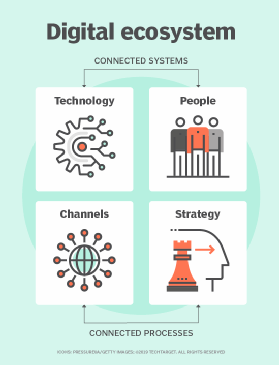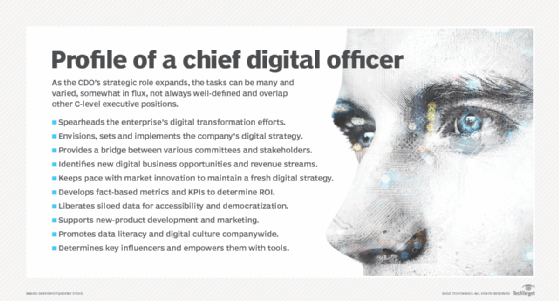digital strategy (digital media strategy)
What is a digital strategy (digital media strategy)?
A digital strategy, sometimes called a digital media strategy, is a plan for maximizing the business benefits of data assets and technology-focused initiatives. A successful digital strategy requires a cross-functional team with executive leadership, marketing and IT members. It involves breaking down the silo between IT leaders and other customer-facing departments to deliver a consistent digital customer experience.
While traditional IT strategies tend to focus on long-term road maps and budget forecasts that extend years into the future, digital strategies rely on short-term, month-to-month road maps that are tied to actionable items and measurable business objectives. To be successful, the strategy should focus on where the company value chain is vulnerable to disruption and could be made stronger and more economically viable from a digital reboot. One of the challenges to establishing a digital strategy is to determine which services should be done in-house, which services should be outsourced to a third-party provider and which services require customization to be effective.
What are the advantages of a digital strategy?
Having a digital strategy in place can provide organizations with the following benefits:
- Increased efficiency.
- Improvements in the speed of business processes.
- Advantages in the marketplace.
- New opportunities for improving an organization's business model.
- Improvements in operations and the optimization of employee efforts by implementing new technology.
A successful digital strategy empowers the business, its leadership and its workforce. Implementing digital business, e-commerce and digital marketing must be approached selectively and with careful evaluation of what new technology is best for the company's ecosystem. An organization should resist the impulse to buy into popular technology trends.
A digital strategy produces a blueprint for building the next version of the business, creating a bigger, broader picture of available options and downline benefits.

What are the goals of building a digital strategy?
An organization should try to ensure its digital strategy achieves the following:
- Highlights new business opportunities, identifying operational and market targets while offering insights into their viability. This strategy should also be able to expose process inefficiencies and opportunities for internal improvement.
- Directly informs business strategy. A solid digital strategy should expose weaknesses in business strategy, while illuminating new strategic options.
- Assists in producing actionable near-term plans, spurring process improvement, growth in the marketplace and improved decision support.
- Identifies new potential customers.
- Differentiates the enterprise from its competitors.
- Improves the value proposition to existing customers.
How do you build a digital strategy?
Building a successful digital strategy begins with putting strong leadership in place. In some companies, the chief information officer (CIO) oversees both customer-facing initiatives and the back-end infrastructure that supports them. In other companies, however, a chief digital officer is appointed to create and execute strategies and provide management with data that demonstrates how digital initiatives are adding value to the company. Either way, a digital strategy should be customer-focused and address ways to improve the company's social media footprint, organic search results, customer engagement and brand recognition. It should also include strategies for reputation management.

An important early step in building a digital strategy is assessment. The digital strategy should be built on the answers to questions such as the following:
- What will its strategic impact be?
- What are our competitors doing and where have we fallen behind?
- What are the potential benefits of each digital strategy option under consideration?
- What are the barriers to implementation?
The digital strategy must lay out the objectives and potential components for digital transformation -- the implementation of new technology and processes that will be used to deploy the strategy.
Building a successful digital strategy often means profound culture change within the enterprise, motivating leadership and employees to take a data-driven, evidence-based attitude to decision-making, policy implementation and process improvement. This can often take a while to achieve, so it should be addressed early and diligently.
Included in the building of a strong digital strategy is the use of tools for measuring how it's functioning.
Finally, the building of a digital strategy should include the adoption of a continuous-improvement mindset and process. A digital strategy that isn't future-proofed could quickly fail; only by perpetually tweaking the strategy and the processes and objectives it supports can an organization avoid that failure.
Digital strategy vs. digital transformation
The terms digital strategy and digital transformation are often used interchangeably; however, even though they're closely related, they aren't quite the same thing. Digital strategy is focused on the technology that will be supporting change in the enterprise and how business models will be adapted to support digital business. Digital transformation, on the other hand, is more about the hands-on operational processes affecting the customer experience and customer relationships and making new business models achievable.
Examples of digital strategy
Instances of successful digital strategies are all around. The following is a sampling:
- Adobe, already a highly successful software company, transitioned in 2013 from selling traditional physical software to completely cloud-based services, greatly expanding its market and the accessibility of its products.
- Starbucks created a mobile app for ordering and paying for coffee, adding a digital customer loyalty program; sales rapidly increased, and countless businesses followed suit.
- Netflix scored a huge success by offering mail-order movie rentals but rose to the next level by replacing that model with its internet-based streaming service, which spawned many imitators.
- Renault implemented a digital strategy of internal process improvement, setting a goal of increasing earnings before interest and taxes by 25%; the company tried out 15 digital initiatives to achieve this goal across all departments to assess which were most effective.
Digital strategy tools
Once implemented, a digital strategy must be perpetually monitored to gauge its effectiveness. Examples of tools for evaluating the success of a digital strategy include Amazon Alexa, Facebook Analytics, Google Analytics, HubSpot, IBM Cognos Analytics and Sprout Social.
With the uncertainty of the economy, organizations need to seek alternative marketing strategies. Learn which digital marketing techniques marketers can use to help maximize customer success.







